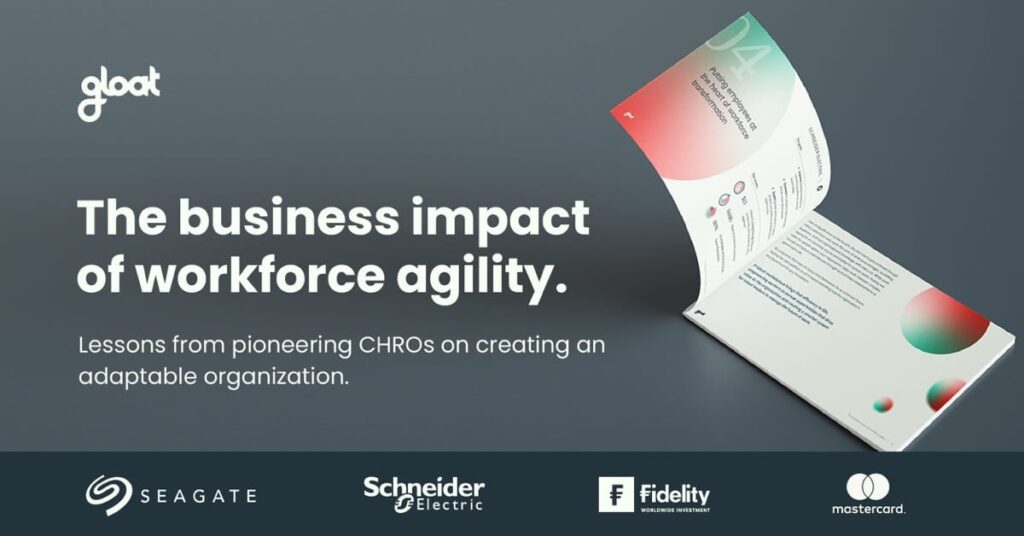What is agility and why is it a workforce essential?
Dynamic ways of working will be a prerequisite for success. Here’s why:

Agility isn’t a buzzword—it’s the guiding light in this new world of work. Leaders can’t go far without reading about agile transformations or hearing colleagues tout the benefits of more dynamic ways of working.
In a new chapter of work already hallmarked by accelerated timelines and ongoing disruptions, there’s no question that agile organizations are best positioned to come out on top. COVID-19 may have been what put workplace agility on many executives’ radars, but the need to rapidly shift gears has only continued to grow in the years following the pandemic, particularly as the proliferation of AI promises to profoundly change job and skill needs.
By now, most leaders are aware of the benefits associated with embracing more agile ways of working. Yet, there’s still a lot of uncertainty about what workplace agility looks like in action and the steps businesses must take to devise more fluid strategies.
What is workplace agility?
Workplace agility is the ability of an organization and its employees to adapt quickly to change, respond to new challenges, and shift priorities efficiently. It promotes flexibility, rapid decision-making, and continuous improvement, helping businesses remain competitive in fast-changing environments.
What does agility mean in the context of work?
The word agile gets used a lot, but it has a specific meaning when it comes to workplace structures. Organizations can only be considered agile when their entire workforce embraces more dynamic and fluid ways of working.
Leaders must empower their people to develop multiple skill sets, take on new challenges, and continuously pursue emerging opportunities to expand their knowledge and collaborate cross-functionally. To achieve workforce agility, employees need transparency into all of the opportunities their organization has to offer, while managers should be empowered to tap into talent across the business to get key projects across the finish line. This free-flowing exchange of talent requires careful workforce planning, as leaders must anticipate future skills needs and lay the groundwork for ongoing upskilling and reskilling.
The benefits of agile working
Here are some of the top benefits associated with embracing a more dynamic way of working:
#1. Faster response times
Agile workforces minimize silos and rigid hierarchies, the top two culprits for delayed response times. Instead, full skills visibility and networked teams make it easy to efficiently redeploy talent as new priorities emerge. As a result, shifting resources and adapting strategies becomes a smooth process, allowing businesses to respond on the fly.
#2. Improved engagement and retention
Internal mobility is a common denominator amongst agile organizations. Employees are empowered to take on new projects and pitch in, which in turn keeps them engaged and ensures that workers will continue to grow and develop their skills.
#3. Greater innovation
An agile workforce encourages employees to share their ideas, build new skills, and tackle projects that might be outside of their comfort zone. These organizations minimize hierarchies and move away from top-down cultures, which motivates people from across the organization to voice new suggestions and bring ideas to bear faster.
#4. Risk mitigation
In our era of accelerating digital innovation and ongoing market turbulence, every business must be prepared to shift gears at a moment’s notice—or deal with the consequences. Agile organizations that can rapidly redeploy talent are in the best position to efficiently respond to unforeseen challenges, whether that’s a shift in consumer demand or a delay in the company’s supply chain.
#5. Cost efficiency
When companies empower their people to lend their skills to projects across their organization, they can reduce or even eliminate the need for freelancers and contractors. As employees get comfortable performing a wider range of tasks, organizations can minimize their spending on additional talent resources and instead become more cost-efficient.
4 challenges of agile working
While there are many advantages associated with embracing more agile ways of working, there are also a handful of challenges that leaders should watch out for. A few of the most common obstacles include:
#1. Cultural shift and resistance to change
Transitioning from a traditional work hierarchy to a more agile organizational structure is a marked shift that will take time for employees and leaders to adjust to. The transition process can be particularly challenging for managers who are used to relying on the same all-star employees to get key projects across the finish line. While some of these leaders may be tempted to hoard this talent, agile workforces must cultivate a culture of talent sharing in which employees are empowered to lend their skills to leaders across the business.
#2. Communication
If your agile transformation isn’t well communicated to your entire organization, your people will struggle to get behind it. Rather than letting employees find out about the changes you’re enacting once they’re in motion, the most effective leadership strategy is to begin spreading the word about your transformation initiative ahead of time. Give employees the opportunity to have their questions answered and learn the reasoning behind your leadership team’s decision to become more agile to maximize your strategy’s success.
#3. Leadership and management
Agile organizations operate entirely differently from their more static competitors. Shifting to flatter and more networked teams may be a difficult adjustment for leaders and managers who have grown accustomed to more traditional, top-down ways of working. That’s why it’s so important to get leaders and managers on board with your change vision and to harness tools like a talent marketplace, which are designed to facilitate the dynamic movement of talent to high priority business projects and tasks.
#4. Employee well-being and engagement
Change isn’t just a challenge for your management team; it can also be difficult for employees who’ve grown accustomed to specific working conditions. However, transitioning to an agile operating model can be hugely beneficial for your workforce, as they will have the opportunity to work on projects that align with their skill sets and aspirations. When people are performing tasks that feel meaningful and aligned with their sense of purpose, they are more likely to feel engaged and fulfilled by the work that they’re doing.
4 hallmarks of agile organizations
Although every business’s approach to accelerating innovation will vary, there are a few best practices that most agile organizations have in common:
#1. Skills-based strategies
Skills are the backbone of every agile organization. Businesses that embrace skills-based strategies are inherently agile because these companies break down work into tasks, rather than jobs, and match employees to projects based on the skills they have and the knowledge they wish to acquire.
To become a skills-based organization, all employees need full visibility into the opportunities available to them throughout their company. At the same time, employers must gain a comprehensive understanding of the skills their organization has, the knowledge gaps that are emerging, and the areas of expertise they must prioritize next.
#2. Autonomy and flexibility
Strict job structures and rigid hierarchies have no place in an agile organization. Instead of expecting employees to adhere to stringent guidelines and stick to obsolete operating models, people at agile organizations are empowered to challenge the status quo.
Employees at these companies are placed at the helm of their career development and are encouraged to make their own decisions about which learning and training opportunities they wish to pursue. Agile workplaces spend less time dictating where and when work gets done, and more time executing the strategic priorities that will set their business apart.
#3. A culture of inclusivity
At agile organizations, all employees gain access to the same breadth of skill-building activities and developmental opportunities. In contrast, traditional workplaces often fail to create a level playing field for their entire workforce, since access to opportunities often depends on external factors like who an employee knows.
When businesses remove biases and barriers from the equation, every team member will be empowered to apply for opportunities across the organization. As a result, managers can tap into qualified talent whose experience and expertise may have once gone unnoticed.
#4. Skills intelligence
Skills intelligence tools are what bring visions for agile, skills-based organizations to life. Without a full picture of the capabilities within an organization and the competencies that must be developed, leaders will struggle to make the strategic workforce planning decisions needed to pivot their strategies.
The most impactful skills intelligence offerings create a central platform that provides the actionable insights needed to design future-fit workforces. Gloat’s Skills Foundation platform includes offerings that are crucial for powering agile organizations, such as a Skills Management Console, Job Architecture Console, and Workforce Insights.
Want to learn how leading organizations like Mastercard and Seagate are harnessing AI-powered technology to unlock agility? Check out our guide, The business impact of workforce agility.





